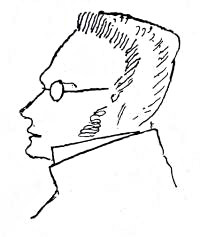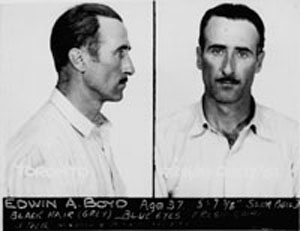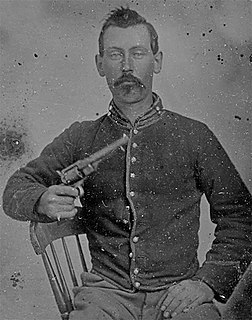Related Research Articles

Richard Turpin was an English highwayman whose exploits were romanticised following his execution in York for horse theft. Turpin may have followed his father's trade as a butcher early in his life but, by the early 1730s, he had joined a gang of deer thieves and, later, became a poacher, burglar, horse thief and killer. He is also known for a fictional 200-mile (320 km) overnight ride from London to York on his horse Black Bess, a story that was made famous by the Victorian novelist William Harrison Ainsworth almost 100 years after Turpin's death.

The Dalton Gang was a group of outlaws in the American Old West during 1890–1892. It was also known as The Dalton Brothers because four of its members were brothers. The gang specialized in bank and train robberies. During an attempted double bank robbery in Coffeyville, Kansas in 1892, two of the brothers and two other gang members were killed; Emmett survived and was captured, tried, and convicted. He was paroled after serving 14 years in prison.
Wo Shing Wo or WSW is the oldest of the Wo Group triad societies, and is the triad with the longest history in Hong Kong. According to the Hong Kong police, the triad is involved in extortion, drug trafficking, gambling and prostitution.

Pacific Mall is an Asian shopping mall in Markham, Ontario, Canada. It is the largest indoor Asian shopping mall in North America and has been reported as the largest Asian shopping mall in the Western world. The mall is located on the northeast corner of Steeles Avenue and Kennedy Road, along the city limits with Toronto. Opened in the mid-1990s amid a period of significant Chinese immigration to Canada, the mall operates as a condominium corporation with 450 individual units. The mall also includes Heritage Town, a food court and market that functions as a notable tourist destination in the Greater Toronto Area.

Illegalism is a tendency of anarchism that developed primarily in France, Italy, Belgium and Switzerland during the late 1890s and early 1900s as an outgrowth of individualist anarchism. Illegalists embrace criminality either openly or secretly as a lifestyle. Illegalism does not specify the type of crime, though it is associated with theft and shoplifting.

Edwin Alonzo Boyd was a Canadian bank robber and leader of the Boyd Gang. His career made him a notorious Canadian folk hero.
Sherman McMaster (1853–1892) was an outlaw turned lawman, who was one of the six men involved in the Earp vendetta ride.
The Forty-Two Gang is a teenage street gang in Chicago that started during Prohibition. Like Brooklyn's Italian and Jewish street gangs of Brownsville and Ocean Hill, the Forty-Two Gang serves as a "farm team" for future members of the Chicago Outfit. Forty-Two Gang members include future syndicate members Sam Giancana, Sam "Teets" Battaglia, Luigi "Cockeyed Louie" Fratto, Felix "Milwaukee Phil" Alderisio, "Mad Sam" DeStefano, Charles "Chuckie" Nicoletti, Fiore "Fifi" Buccieri, William "Smokes" Aloisio, Frank "Skids" Caruso, William "Willie Potatoes" Daddano, Joseph DiVarco, Marcello Caifano, Mario DeStefano, Bruno Tassione, and Joey "Cowboy" Miletta.

The Banditti of the Prairie, also known as The Banditti, Prairie Pirates, Prairie Bandits, and Pirates of the Prairie, in the U.S. states of Illinois, Indiana, and Ohio, and the Territory of Iowa, were a group of loose-knit outlaw gangs, during the early to mid-19th century. Though bands of roving criminals were common in many parts of Illinois, the counties of Lee, DeKalb, Ogle, and Winnebago were especially plagued by them. The new crime wave in the region of the frontier Midwest may have occurred following the crackdown on Southern outlaws by the rising vigilante-regulator movement and the breakup of the criminal syndicate of John A. Murrell and his gang, the "Mystic Clan" in the Southern United States. In 1841, the escalating pattern of house burglary, horse and cattle theft, stagecoach and highway robbery, counterfeiting, and murder associated with the Banditti had come to a head in Ogle County. As the crimes continued, local citizens formed bands of vigilantes known as Regulators. A clash between the Banditti and the Regulators in Ogle County near Oregon, Illinois, resulted in the outlaws' demise and decreased Banditti activity and violent crime within the county.
Born to Kill, also known as BTK or Canal Boys, is the name of a New York City-based street gang composed of first-generation Vietnamese immigrants. They were active in the 1980s in New York City's Chinatown. The early 1990s proved to be detrimental to the Vietnamese collective following the arrest and prosecution of most of their New York-based operatives by the fall of 1992. BTK is said to have formed into Mafia organized crime in 2020, spanning from the Tri-State area to Australia. Gang task reports the Duong Family as the new leader of the New York chapter; due to a long murderous war between the Hip sing Tong’s spanning from 2009 through 2018.
The Reno Gang, also known as the Reno Brothers Gang and The Jackson Thieves, were a group of criminals that operated in the Midwestern United States during and just after the American Civil War. Though short-lived, they carried out the first three peacetime train robberies in U.S. history. Most of the stolen money was never recovered.
Juan Flores was a 19th-century Californio bandit who, with Pancho Daniel, led an outlaw gang known as "las Manillas" and later as the Flores Daniel Gang, throughout Southern California during 1856-1857. Although regarded by historians as a thief and outlaw, Flores was considered among Mexican-Americans as a folk hero akin to Jesse James and who was thought of as a defender against vigilante movements in the years following the American settlement of California and its incorporation into the United States. However, the activities of Flores and other insurrectos such as Salomon Pico and Joaquín Murrieta against American and foreign-born settlers not only created long-lasting suspicion and hostility towards Mexican-Americans but also divided the traditional Spanish class structures of the Californios and the poorer peasants as well.

Mason Frakes Dalton, called Bill Dalton, was an American outlaw in the American Old West. He was the co-leader of the Wild Bunch gang and he was the brother of the founders of the Dalton Gang, Gratton, Bob and Emmett.

Gratton Hanley "Grat" Dalton was an American outlaw in the American Old West. He was one of three brothers in the Dalton Gang, led by his younger brother Bob Dalton. Both brothers were killed during a shootout in an ill-fated raid on two banks in Coffeyville, Kansas. Their brother Emmett Dalton survived to be convicted and imprisoned for fourteen years.

Sile Doty was an infamous robber, burglar, horse thief, highwayman, counterfeiter, and criminal gang leader. Stewart Holbrook says that Doty "was, before the James-Younger era, the most energetic and notorious all-around bandit in the United States." Doty's criminal career is known primarily through his autobiography, compiled by J. G. W. Colburn and published four years after Doty's death as The Life of Sile Doty The Most Noted Thief and Daring Burglar of His Time. As this title suggests, the tone of the autobiography is boastful and unapologetic. Doty excuses his crimes as stealing from the rich to give to the poor. Except where otherwise noted, what follows is taken from the autobiography and may contain exaggerations and self-serving distortions.

James Andrew "Dick" Liddil was an American outlaw who was one of the last surviving members of the James-Younger Gang. His surname is often misspelled as Liddel, Liddell, or Liddle.
Norman "Red" Ryan, was a notorious gangster in early 20th century Toronto, Ontario. He came from an Irish Catholic upbringing and he took to the streets as a young man to engage in crime. He was called the 'Jesse James of Canada' and he was known for armed robbery, safecracking, and other major theft. He killed six people in his career. He was arrested in Minnesota on December 14, 1923 and given life imprisonment, which he served in Canada. He served his sentence at Kingston Penitentiary. He was killed in a liquor store in Sarnia by a police officer after being shot 3 times.

Volney Everett "Curley" Davis was an American bank robber and Great Depression-era outlaw. A longtime Minnesota bandit, he was the boyfriend of Edna Murray and an associate of both the John Dillinger and Alvin Karpis-Barker gangs during the 1930s.

William O'Brien, better known as Billy Porter but also known by the alias William or Billy Morton, was an American burglar and underworld figure in New York City during the mid-to late 19th century. He and partner Johnny Irving were longtime members of the Dutch Mob along with Little Freddie and Michael "Sheeny Mike" Kurtz. He was present during the 1883 gunfight at Shang Draper's saloon in which Irving was shot and killed by rival John "Johnny the Mick" Walsh. O'Brien then killed Walsh and was himself gunned down by Shang Draper. Although surviving his wounds, he was tried for, and acquitted of, Walsh's death.
Flores Daniel Gang, was an outlaw gang also known as "las Manillas", throughout Southern California during 1856-1857. Californio's Juan Flores and Pancho Daniel. Contemporary newspaper accounts of las Manillas all reported that the leader of las Manillas was originally Pancho Daniel, but that Juan Flores assumed the leadership role after Daniel was injured in the Barton ambush. According to the account of Harris Newmark, Flores had been sent to prison for horse-stealing and was just another member of the gang.
References
Notes
Bibliography
- "An Account of the Markham Gang", Scobie & Balfour, 1846
- Edward Butts, "The Desperate Ones: Forgotten Canadian Outlaws", Dundurn Press, 2006, ISBN 1-55002-610-0
- Antonio Nicaso, "Extortion and racketeering, Part 2", Tandem, 24 June 2001
- "Mayhem to Murder", Paul Arculus, 2003
Further reading
- Paul Arculus, "Mayhem to Murder: The History of the Markham Gang", Observer Publishing, 2003, ISBN 0-9684932-5-4